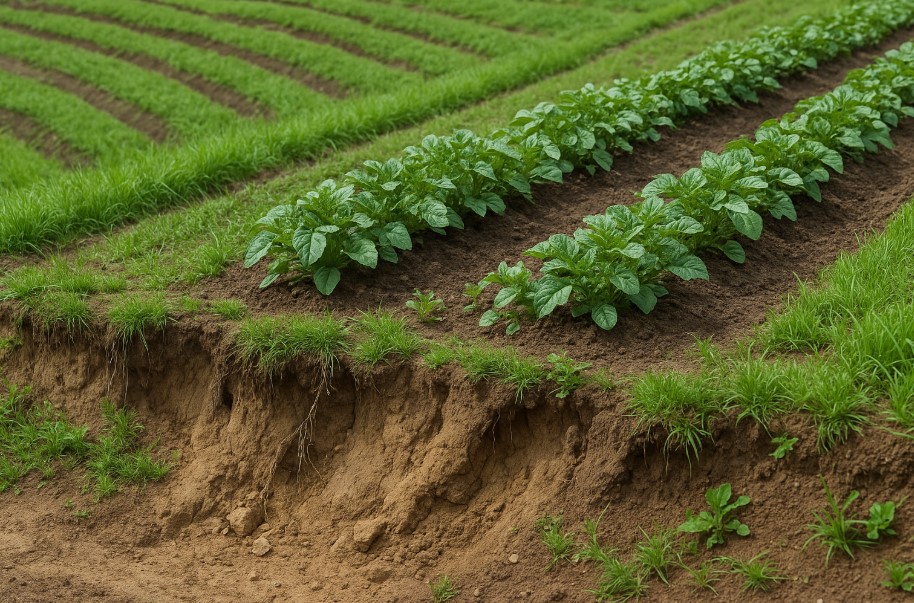Garden
Easy Ways to Keep Soil Healthy and Improve Its Quality

Soil is the base of every garden, farm, or natural area. Whether you’re growing food, flowers, or simply trying to protect the environment, healthy soil is essential. Soil health affects how plants grow, how much water the ground holds, and how nutrients move in the ecosystem. Understanding how to keep soil healthy can help you grow better crops, reduce pollution, and support the environment.
In this blog post, we will explore practical and simple ways to maintain healthy soil. These methods work for home gardeners, farmers, and anyone who cares about soil quality. We will also look at the importance of healthy soil and the role of soil microbes in supporting plant life.
Understanding the Importance of Healthy Soil
Healthy soil supports plant growth, stores water, and filters harmful substances. It contains air, water, minerals, organic matter, and living organisms. These elements work together to support crops, gardens, and natural landscapes.
The importance of healthy soil goes beyond just growing food. It helps reduce erosion, fights climate change by storing carbon, and supports biodiversity. When the soil is unhealthy, plants suffer, water runs off instead of soaking in, and valuable nutrients are lost.
Signs of Healthy Soil
Before we look at how to maintain healthy soil, it is helpful to know what healthy soil looks like. Signs include:
- Dark color and crumbly texture
- Earthworms and other soil organisms are present
- Good drainage, but still holds moisture
- Strong plant growth without the need for too many fertilizers
- No foul smells or signs of decay
Now, let’s move to the practical part:
How to Keep Soil Healthy
-
Add Organic Matter Regularly

One of the best ways to maintain soil quality is by adding organic matter. Compost, manure, and leaf mulch are good options. Organic matter feeds the soil organisms and improves soil structure. It also helps the soil hold water and nutrients.
Try adding compost to your garden beds at least once or twice a year. Avoid using raw kitchen waste directly, as it may attract pests and take time to break down. Composting is a great way to recycle and support soil health.
-
Practice Crop Rotation

If you grow food, especially vegetables, crop rotation is an important practice. Growing the same plants in the same spot every year can damage the soil. It can lead to pests, diseases, and nutrient imbalances.
Rotate crops by planting different types of vegetables in different spots each season. For example, follow a leafy green crop with a legume like beans. This simple method supports soil structure and helps manage pests naturally.
-
Use Cover Crops

Cover crops are plants that you grow not to harvest but to improve the soil. They protect the soil from erosion, add nutrients, and feed soil microbes. Common cover crops include clover, rye, and vetch.
In off-seasons or after harvesting your main crop, plant a cover crop. Let it grow and then cut it down and mix it into the soil. This method is an effective way to keep soil health in good condition.
-
Reduce Tilling

Tilling is the process of turning the soil. While it is common in gardening and farming, too much tilling can hurt the soil. It breaks down soil structure, disturbs microbes, and causes erosion.
Try no-till or low-till gardening methods. Use mulch to control weeds instead of tilling. When planting, dig only as much as needed. This helps protect the natural soil layers and microbial life.
-
Add Mulch

Mulching is one of the easiest ways to protect and improve your soil. Organic mulch such as straw, wood chips, or grass clippings helps the soil in many ways. It keeps the temperature steady, holds moisture, and reduces weed growth.
Mulch also breaks down slowly, adding organic material to the soil. This supports the soil microbes and improves structure over time.
-
Test and Adjust Soil pH

Healthy soil has the right balance of acidity and alkalinity. If the pH is too high or too low, plants can’t absorb nutrients properly. This can lead to poor growth and soil degradation.
You can buy a soil testing kit or send a sample to a local lab. Based on the results, you may need to add lime to raise the pH or sulfur to lower it. Understanding your soil’s pH is a key part of how to maintain healthy soil.
-
Avoid Chemical Overuse

Many fertilizers and pesticides can damage the soil if used too much. They may kill helpful organisms and lead to salt build-up. Over time, this reduces the soil’s ability to support plant life.
Use natural or organic fertilizers and pest control methods when possible. Compost tea, worm castings, and seaweed-based products are gentle on the soil and support the soil microbiome.
-
Encourage Soil Microbes

Soil microbes are tiny organisms such as bacteria, fungi, and protozoa. They break down organic material, fix nitrogen, and protect plants from diseases. Knowing how to make the soil microbiome stronger is essential for long-term soil health.
Feed microbes with compost, keep soil moist but not soggy, and avoid disturbing the soil too much. Avoid harmful chemicals and allow the natural food web to develop. Healthy microbes lead to stronger, more productive plants.
-
Prevent Soil Erosion

Erosion is the loss of the top layer of soil. This layer is where most of the nutrients and life exist. Erosion happens through wind, water, or poor land management. Preventing erosion is one of the key ways to maintain soil quality.
Use plants with strong roots to hold the soil. Cover bare ground with mulch or cover crops. On slopes, try terracing or planting grass strips. These steps keep the soil in place and protect its health.
-
Water Properly

Too much or too little water can harm the soil. Overwatering leads to compacted soil and nutrient leaching. Underwatering dries out the soil and kills microbes.
Water early in the morning or late in the evening to reduce evaporation. Use drip irrigation if possible. Always water the roots, not the leaves. Good watering habits are important when learning how to keep soil healthy.
-
Compost at Home

Making compost at home is easy and very beneficial for your soil. You can use kitchen scraps, yard waste, and shredded newspaper. Avoid meat, dairy, and oily items in your compost.
Turn your compost pile regularly to help it break down faster. In a few months, you’ll have rich, dark compost to add to your soil. Composting supports the soil microbiome and reduces waste.
-
Add Biochar

Biochar is a natural product made from burning organic matter in a low-oxygen environment. It helps hold nutrients and water in the soil and supports microbial life.
You can buy biochar or make it at home if you have the tools. Mix it into your compost before adding to soil. It is a long-lasting way to boost soil health.
-
Grow a Variety of Plants

Diverse plant types support diverse soil organisms. Monoculture, or growing only one type of plant, can damage soil over time. In your garden or farm, mix vegetables, herbs, flowers, and legumes.
Planting a variety encourages different roots, feeding different microbes and insects. This helps balance the ecosystem and improves the quality of the soil.
-
Choose Native Plants

Native plants are well-suited to your local environment. They need less water, fewer chemicals, and can improve the soil naturally. They also support local pollinators and wildlife.
If you’re building a garden or restoring land, include native species. This is a natural way to protect the soil and promote its long-term health.
-
Educate and Share

One of the best things you can do is share your knowledge. Teach others how to keep soil health strong in their gardens, farms, or green spaces. Soil education helps communities make better choices and protect the environment.
Even small changes in soil care can have a big impact when many people apply them. Join community garden projects or support sustainable farming in your area.
Conclusion
Healthy soil is key to a healthy environment. By learning how to keep soil healthy, we protect not just our gardens, but the food system and natural world around us. From using compost and mulch to planting cover crops and reducing chemical use, there are many effective ways to maintain soil quality. If you’re wondering which activity improves soil health the most, the answer often depends on your soil’s needs—but consistent care and attention always make a difference.
Understanding the importance of healthy soil helps us see the bigger picture. And by supporting the soil microbiome and following natural practices, we give our plants the best chance to grow strong. Start with small steps, be patient, and let nature do the rest. Healthy soil is built over time, but the rewards are worth it.
-

 Social Media2 months ago
Social Media2 months agoWhat the “67” TikTok Meme Really Means
-

 Tech2 months ago
Tech2 months agoWhat To Do When Your Business Faces Network Vulnerabilities
-

 Self Improvement2 months ago
Self Improvement2 months agoUsing BCBS Rehab to Access Quality Addiction Care
-

 Games2 months ago
Games2 months agoPusoy Strategies for Play That Also Work in Pusoy Dos in English






